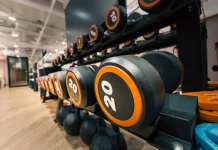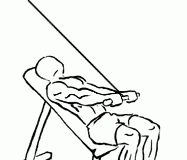Last Updated on November 1, 2024
The lying squat is an effective exercise similar to the leg press, targeting the lower body muscles, including the quadriceps, hamstrings, glutes, and calves. This movement provides many of the same benefits as a traditional squat but with added support, reducing strain on the back and allowing for a controlled range of motion. Whether you’re new to leg training or looking to enhance your lower body routine, this guide will cover everything you need to know about performing the lying squat, its benefits, step-by-step instructions, common mistakes, and tips for maximizing results.
Why the Lying Squat is Essential for Leg Development
- Targets Major Leg Muscles
The lying squat focuses on the quadriceps, hamstrings, glutes, and calves, offering a complete workout for the lower body. This combination of muscle engagement builds strength and definition, essential for functional movement and balanced aesthetics. - Provides Support and Stability
Compared to traditional squats, the lying squat places less stress on the lower back, making it ideal for individuals with back sensitivities. The machine-supported movement allows for controlled form and reduces the risk of injury. - Increases Muscle Activation with Minimal Strain
The lying squat allows for a full range of motion, activating the muscles without placing excessive strain on the joints. By adjusting the machine, you can customize the movement to suit your range of flexibility and comfort. - Improves Lower Body Strength and Endurance
Strengthening the lower body contributes to improved performance in various physical activities, including running, jumping, and lifting. Consistent practice with the lying squat can enhance muscle endurance and boost athletic performance. - A Great Alternative to the Leg Press
If you don’t have access to a leg press machine, the lying squat is a fantastic alternative that targets the same muscles and offers similar benefits. It’s especially useful in a gym setting where equipment may be limited.
How to Perform the Lying Squat: Step-by-Step Guide
To get the most out of the lying squat, follow these steps to ensure proper form and muscle engagement:
1. Set Up the Machine
Start by adjusting the shoulder rack of the machine so that your feet comfortably reach the crosspiece with a slight bend in your knees. This setup ensures a full range of motion without overextending or straining your legs.
2. Position Your Feet and Unload the Weight
Position your feet shoulder-width apart on the platform, ensuring they are aligned with your knees and hips. Press your feet forward to release the safety locks, allowing you to lower and lift the weight freely.
3. Lower the Weight in a Controlled Motion
Inhale as you slowly lower the weight toward your body, bending your knees and keeping your abs engaged. Allow your knees to move in line with your feet as you lower the weight until your legs form a 90-degree angle. This depth maximizes muscle activation without overstressing the joints.
4. Avoid Locking Your Knees or Bouncing the Weight
Do not lock your knees at the top of the movement, as this can place undue strain on the knee joints. Also, avoid bouncing the weight, which reduces control and muscle engagement.
5. Press Back Up to Starting Position
Exhale as you press the weight back up, straightening your legs without fully locking your knees. Focus on controlled movements to keep the emphasis on the muscles rather than joint strain.
6. Repeat for Desired Repetitions
Complete your chosen number of reps before resting. Aim for 3-4 sets for an effective leg workout.
Tips for Maximizing the Lying Squat
- Maintain a Steady Tempo
Avoid rushing through the exercise. Focusing on a slow, controlled tempo increases muscle tension and improves form, leading to better results over time. - Engage Your Core
Keep your core muscles engaged throughout the movement to support your lower back and improve stability. A strong core also helps prevent your hips from lifting off the platform, keeping the focus on your legs. - Focus on Breath Control
Breathe out as you press the weight up and inhale as you lower it down. Proper breathing technique improves performance and helps maintain control during each rep. - Avoid Locking Out Your Knees
Maintaining a slight bend in your knees keeps tension on the muscles and protects your joints from strain. Locking out reduces muscle engagement and can lead to injury. - Use an Appropriate Weight
Start with a lighter weight to master your form, gradually increasing as you build strength. Choosing a manageable weight ensures that you maintain proper control and maximize muscle activation.
Common Mistakes to Avoid
- Using Excessive Weight
Lifting too heavy can compromise form and increase the risk of injury. Begin with a weight that allows for proper control and focus on gradually increasing resistance over time. - Bouncing the Weight
Allowing the weight to bounce reduces the effectiveness of the exercise and can cause knee strain. Aim for smooth, controlled movements, especially at the bottom of the lift. - Lifting Hips Off the Platform
Keeping your hips flat against the platform ensures correct form and prevents strain on the lower back. Engage your core to prevent unnecessary movement. - Letting Knees Drift Inward
Ensure that your knees stay aligned with your toes throughout the movement. Allowing your knees to collapse inward can place unwanted stress on the joints and reduce muscle engagement. - Neglecting the Eccentric Phase
Lowering the weight quickly sacrifices muscle tension. Take your time with the eccentric (lowering) phase to ensure continuous tension and better results.
Variations of the Lying Squat
- Single-Leg Lying Squat
Perform the lying squat one leg at a time to address muscle imbalances and increase stability requirements. This variation is more challenging but helps improve unilateral strength and coordination. - Narrow Stance Lying Squat
Position your feet closer together on the platform. This variation places greater emphasis on the outer quadriceps and helps create balanced leg development. - Wide Stance Lying Squat
Set your feet wider apart to engage the inner thighs and glutes more intensively. A wide stance is beneficial for those aiming to target the adductor muscles. - Calf Raises at the Top of the Squat
At the top of each lying squat, perform a calf raise by pressing through the balls of your feet. This variation allows you to work both the calves and legs, making it an efficient addition to your lower body workout. - Tempo-Controlled Lying Squat
Slow down each phase of the lift, especially the lowering (eccentric) phase. This increase in time under tension stimulates muscle growth and enhances muscle control.
Incorporating the Lying Squat into Your Workout
The lying squat is a versatile exercise that can be included in your lower body or leg workout routine. Here’s how to incorporate it based on your fitness goals:
- Strength Training
For strength, perform 3-5 sets of 4-6 reps with a challenging weight. This lower rep range allows you to lift heavier and develop greater muscle strength. - Hypertrophy (Muscle Growth)
To build muscle, aim for 3-4 sets of 8-12 reps with a moderate weight. This rep range increases muscle tension and is ideal for creating bigger, more defined leg muscles. - Endurance and Tone
For muscle endurance and toning, perform 2-3 sets of 15-20 reps with lighter weight. This high-rep approach helps improve muscle endurance and overall leg tone. - Use as a Finisher
Perform the lying squat at the end of your leg day to fully exhaust your muscles. Aim for 2-3 sets of 12-15 reps to maximize muscle fatigue and build endurance. - Pair with Compound Leg Exercises
Combine the lying squat with other compound movements like lunges or deadlifts for a comprehensive lower body workout that targets multiple muscle groups.
Safety Tips for Performing the Lying Squat
- Start with a Manageable Weight
Avoid using excessive weight, especially if you’re new to the exercise. Starting light allows you to focus on form, reducing the risk of injury and maximizing muscle activation. - Maintain a Neutral Spine
Keep your back pressed against the platform to avoid straining your lower back. A stable spine ensures safer, more effective lifting. - Monitor Your Knee Alignment
Ensure that your knees move in line with your toes throughout the exercise. Allowing the knees to collapse inward can strain the joints and reduce muscle engagement. - Avoid Locking Your Knees
Keep a slight bend in your knees at the top to prevent joint strain and ensure continuous muscle tension. - Progress Gradually
Avoid sudden increases in weight. Gradual progression is safer and helps prevent injury while supporting steady strength gains.
Frequently Asked Questions
Q1: Is the lying squat suitable for beginners?
A: Yes, the lying squat is beginner-friendly and provides extra support for those who may be new to lower body training. Start with lighter weights and focus on mastering form.
Q2: How often should I do the lying squat?
A: Include this exercise in your leg workout once or twice a week, with at least 48 hours between sessions for proper recovery.
Q3: Can this exercise replace traditional squats?
A: While the lying squat is an effective alternative, it doesn’t entirely replace the benefits of traditional squats. Traditional squats engage the core and stabilizing muscles more intensively. Incorporating both exercises can help build balanced leg and core strength.
Q4: Should I perform the lying squat with my feet placed high or low on the platform?
A: The placement of your feet can target different muscles. A higher foot placement emphasizes the glutes and hamstrings, while a lower placement focuses more on the quadriceps. Experiment with different positions to see which muscles you feel working more.
Q5: Can I use the lying squat for injury rehabilitation?
A: For some individuals, the lying squat can be a joint-friendly exercise that reduces strain on the lower back and knees. However, consult a healthcare professional or physical therapist before adding it to your rehab routine to ensure it’s appropriate for your condition.
Advanced Tips for Maximizing Results from the Lying Squat
- Slow Down the Eccentric Phase
Lowering the weight slowly during the eccentric (downward) phase increases time under tension, which is beneficial for muscle growth. Aim to lower the weight in 3–4 seconds to maximize results. - Try Partial Reps for Added Intensity
After reaching muscle fatigue, add partial reps by moving through only the bottom half of the range of motion. This technique adds intensity, challenging your muscles to push through exhaustion. - Add Resistance Bands
Loop a resistance band around your thighs for additional tension, especially near the top of the movement. This extra resistance engages the glutes and outer thigh muscles, enhancing the workout. - Use a Narrow and Wide Stance Combination
Perform one set with a narrow stance and the next with a wider stance to hit all areas of the leg muscles. Alternating stances allows for balanced development in the quadriceps, hamstrings, and glutes. - Mind-Muscle Connection
Concentrate on each muscle working as you perform the lying squat. Visualizing the target muscles, like the glutes and quads, can improve muscle activation, resulting in more effective reps and enhanced muscle growth.
Wrapping Up: Build Powerful Legs with the Lying Squat
The lying squat is a versatile and effective exercise for building strength, size, and definition in the legs. With the support of the machine, it provides a controlled environment that allows for muscle isolation and reduces strain on the lower back. Perfect for both beginners and advanced lifters, this exercise delivers a well-rounded leg workout when performed with proper form and intention.
Whether you’re aiming to improve athletic performance, enhance lower body aesthetics, or build functional strength, the lying squat is a valuable addition to any workout routine. By incorporating variations, paying attention to form, and using gradual progression, you can maximize the benefits of this movement and build a strong, well-defined lower body.
Add the lying squat into your routine to target your quadriceps, glutes, hamstrings, and calves effectively. With consistent effort, this exercise will help you achieve powerful, sculpted legs and take your lower body training to the next level.






